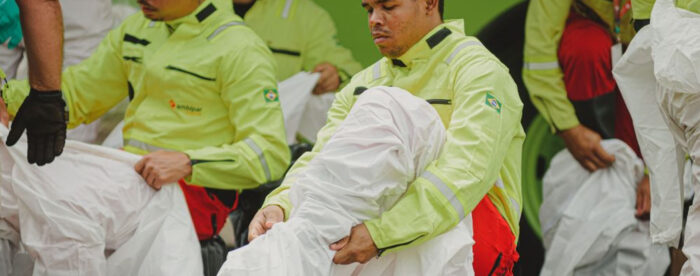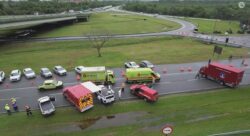Occurrences involving hazardous products are complex and require quick responses to minimize environmental impacts

By Equipe de Redação
Posted in March 22, 2021

When hazardous substances leak from tanks, tankers or other types of equipment, it is time to call in a specialized response team. These occurrences are complex and require professionals to resolve the problem quickly. Environmental emergencies happen due to the spill or leak of various types of products – whether hazardous or not – that alter the natural characteristics of the environment. But why do we classify them this way?
Environmental emergencies are those that bring about any type of negative impact on the environment. They can occur in different transportation modals: railroad, industrial, airport, road, maritime, river or pipeline.
Railroad:
The railroad modal brings a unique complexity to the emergency response due to difficult access by road in several stretches. Thus, the assistance of specialized teams can be done on a scheduled basis, such as technical cleaning of areas with confined products or accidents with small leaks as well as in emergencies that demand quick product removal to minimize any impacts on the environment and resume normal train traffic.
Industrial:
In large plants, chemicals storage, handling and loading/unloading are routine, as they are often used in the production process or as input for the equipment. Flammable, combustible and corrosive liquids, as well as flammable and toxic gases, are very common in these places and a simple accident can result in explosions or start fires in the premises. An emergency action plan program is required to define quick responses in the event of an accident.
Airport:
Airports may also need an emergency response since product leakage in aircraft cargo compartments is a possibility. Besides, airport premises often have warehouses for storing products that are being imported or exported, some of which may occasionally cause explosions or contamination.
Aircraft refueling is a routine procedure at airports. In the event of any type of fuel leak or spill, emergency response teams need to be called in to respond quickly to the occurrence and ensure safety for people on the site as well as prevent major accidents such as fires or explosions.
Road:
The most common types of emergencies in Brazil take place on roads, where flows most of the country’s transportation of products. In other countries, it is customary for goods to be shipped by railroads or, in some cases, by rivers. However, in Brazil, goods reach stores, shops and supermarkets mostly through road transportation.
The most common environmental emergencies are accidents involving shipments of chemicals or fuels. In such cases, an emergency response team needs to be called in to contain the leak, clean up the site and mitigate environmental impacts, thus avoiding soil, water and air contamination.
Maritime and River:
Seaports have several warehouses for storing products, whether dangerous or not. If a substance gets accidentally mixed with another, serious accidents may result, which makes it is necessary to keep an emergency response team on standby to act upon any kind of problem immediately. Besides the warehouses, oil spills into the sea or rivers are likely to occur. In such cases, emergency response professionals use absorbent materials to carry out the clean-up process and therefore minimize environmental impacts.
The teams need to be specialized in chemicals handling and have Hazmat training with international certifications, in addition to following the Conama[1] 398 guidelines.
Pipeline:
This type of accident occurs due to products’ characteristics and the high pressure inside the pipelines, generating wear, cracks, perforations and operational problems. Thefts also may cause considerable damage to the pipeline integrity. An emergency response team is paramount to ensure a quick and efficient response to the incident.
These types of occurrences can lead to three forms of contamination:
- Air Contamination
In environmental emergencies usually involve hazardous chemicals. Some of them are invisible to the naked eye and can spread in the air, intoxicating people in the area and leading to consequences such as respiratory diseases, among other health problems.
2. Water contamination
In accidents with road tankers transporting fuel, for example, the product may leak from the tank due to the impact. If there is a river close to the accident, its water is likely to be contaminated, which can generate social impacts in case a nearby community is supplied by this river. Anyway, even without the presence of water bodies around, the leaked substances may percolate through the soil and reach the groundwater table and contaminate the water.
3. Soil Contamination
In any type of accident in which chemicals have contact with the soil, be it a road or a location near woods, contamination occurs. It is necessary to employ remediation techniques to clean up the area and mitigate the environmental impacts on that region, as they can impair its fauna and flora.
The step-by-step procedure of emergency response
Responding to emergencies is no easy task. It is required that the professionals are fully trained and that the company enjoys large experience in the market to develop its own protocols defining the step-by-step procedure of a good emergency response service. We have chosen some tips on how to respond to environmental emergencies efficiently.
- Emergency Center
The emergency center team receives the accident report and needs to identify the scenario through analysis by experts. The objective is to understand the type of occurrence and gather as much information as possible. Emergency response professionals are called in to head to the accident site. While on the way, the emergency center continues to request information to define the most appropriate response framework.
2. The team at the emergency site
Upon arriving at the incident, the professionals make a new assessment of the scenario to define the placement of the vehicles and the team members. For that, it takes into account, among other aspects, the terrain slope, wind direction and the safe distance from the accident, according to the chemical involved.
Determining the wind direction is extremely important to protect the response team, since, in case gaseous chemicals are present, it is necessary to place the team members upstream of the wind to prevent the substance from reaching them.
After that, the emergency response plan is set up, marking the position of the hot, warm and cold zones. But do you know what that means?
Hot zone
It is the area where the product leaked or spilled and to which access is restricted to emergency teams.
Warm zone
In this area, a Contamination Reduction Corridor (CRC) is set up to establish the transition between the hot and cold zones.
Cold zone
In the cold zone, the entire operation support is installed together with the command post.
All emergency response planning is defined together with the public authorities that participate in the process and possibly with a representative of the company or institution that caused the accident.
3. Definition of operator protocols, equipment and materials required
The teams then begin to prepare the operators’ safety protocols observing the degree of risk caused by the chemical to define which Personal Protective Equipment (PPE) and Collective Protection Equipment (CPE) will be used in the action. Also, the response team decides which equipment and materials are required, and then the response process starts.
4. Waste Management
After some emergency response operations are completed, there may be a need to handle the waste generated. It is necessary to collect it and make equipment available for transportation to companies specialized in waste management. Then, it is necessary to issue the mandatory documents and the certificate of final disposal of waste.
Personal Protective Equipment
The types of PPE utilized are also very important for emergency response. There are skin and respiratory protective equipment, and each one has safety levels.
Level A
It is the most complete type, in which the professional is free from contact with any external interference through the clothing. It is used in emergencies involving substances that are in general more toxic and cause the emission of hazardous gases. The oxygen cylinder needs to be encapsulated within the suit, after which the Respiratory Protection Equipment (RPE) is positioned.
Level B
It is a semi-encapsulated suit, i.e., that allows the breathable air cylinder to be placed on the outside.
Level C
It is the type of clothing coated with chemical protection, to be used together with masks equipped with breathing filters. This type of PPE is used in environment disinfection services such as, for example, against the new coronavirus.
Level D
It is a type of workwear that complies with safety standards, such as uniforms, safety footwear and helmets. This type of PPE is used routinely and in low-risk situations.
Difficulties in emergency response
Incidents involving chemicals – whether hazardous or not – are always extremely complicated, as professionals need to identify which substances are present and act quickly to minimize or avoid environmental impacts. One of the difficulties of emergencies arises when the chemicals are invisible to the naked eye and odorless.
In such cases, the team needs to use equipment that measures the concentration of gases in the air. However, when more than one type of chemical product is involved, they may mix and, due to chemical incompatibility, cause reactions that generate new substances with different physical, chemical and toxicological characteristics than those of the chemicals initially involved.
Another difficulty that happens is obtaining accurate information about the accident and the position of the equipment that caused the problem. In some cases, they are found at the bottom of streams or places that complicate the removal and the emergency response.
Responding to environmental emergencies is a complex task that involves several professionals and requires action protocols as well as compliance with technical and international standards such as NFPA[2] 472 and ABNT[3] 14064.
Prevention is always the best answer
It is highly recommended that companies that are subject to environmental emergencies always have an Emergency Action Plan (EAP). It provides a set of guidelines, information and data for adopting strategic procedures in the event of an accident. This makes operational teams’ response more agile and able to provide a higher quality service based on defined protocols. This type of document analyzes the company’s facilities and predicts the accidents that are likely to happen. Thus, it is possible to define the emergency response actions, reducing environmental impacts and the response time.
The factors considered in emergencies
To respond to emergencies efficiently, there is a framework of rules, procedures, safety protocols, strategic actions and precautions that must be taken into account. For this reason, providing all assistance through highly qualified and trained expert professionals is essential. In this way, it is possible to reduce socio-environmental impacts and preserve the world for generations to come.
Ambipar is a specialist in crisis management involving health, property and the environment. With more than 150 bases strategically located around the world, it ensures quick and efficient response to emergencies in all modals. We operate in South America, North America, Europe, Africa and Antarctica. Our professionals are fully trained and specialized in emergency care with hazardous chemicals. We utilize a vast array of technological equipment and absorbent products developed to mitigate the environmental impacts caused by the accidents such as those described here.
[1] Conama: Brazil’s National Environment Council
[2] NFPA: National Fire Protection Association
[3] ABNT: Brazilian Technical Standards Association




